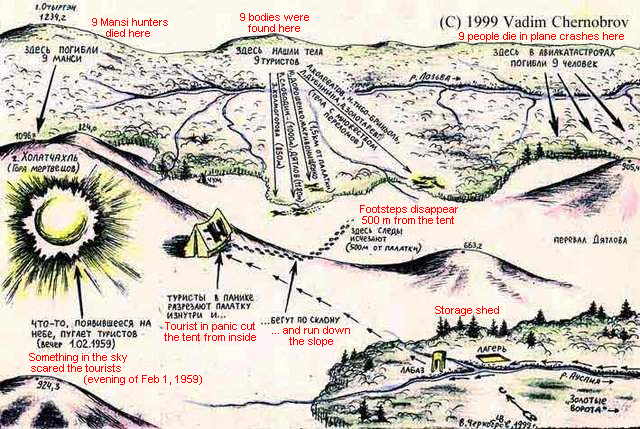I was one of the people who coldly refuted Lemmino's explanation (the smoking stove theory), but in the long run, I found myself glad it came up, because I believe in the rebuttal lies a bit of a hint.
When you consider the night temperatures fell as low as -30 or even -35 °C around February 1st, the mere fact the stove was not assembled for the night begs a question.
Why?
The answer is obvious. They had no firewood. They took none from the storage they set up earlier, because they originally did not plan to spend the night on the slope, but down by the forest line which would have provided enough firewood to make it through the night no matter how cold it was gonna be.
Steering off the planned direction or maybe deciding not to descend at last minute (be it because they did not wanna lose the altitude or because they already were too tired) were the first (second) terrible mistake(s) they made.
Exactly ... The firewood situation at the fatal site atop the pass is something I've long considered a key clue.
Early in the expedition Dyatlov had consulted with experienced folks at one or both the settlements where they'd stayed concerning the route(s) for their intended agenda (to Ortoten and back). There was basically one option for the first part of the trek - follow the Auspiy river valley. The second phase (ascending what's now named Dyatlov Pass) split the possibilities into two options - both of which were discussed in the early consultation(s).
The options were:
(1) to continue from the pass on the 'high road' (the usual summertime route, staying above the tree line from Kholat Syakhl to Ortoten), thus maintaining the altitude they'd gained from climbing to the pass and avoiding having to climb again at Mt. Ortoten.
(2) to cross the pass, descend into the Lozhva river valley, approach Ortoten via this 'low road' through the forests, and then climb to the top of Ortoten.
When they first approached the pass on the preceding day they had intended to scale the pass and descend into the Lozhva valley to establish their cache. This is mentioned in Kolmogorova's diary as her understanding of the plan. In other words, they were originally planning to follow the 'low road' routing. Because they were delayed in reaching the pass area and had more trouble ascending the slope than expected, they had to turn back and pitch camp in the Auspiy valley. They did not build a fire or use the stove that night. In addition, there's a mention in the diaries that firewood at the campsite was wet and unsuitable for readily building a fire. They were notably exhausted, and they ate a cold meal that night.
The only firewood they were carrying was a single substantial chunk / piece which was all they needed as a reserve if following the 'low road' plan and assuming they could easily collect firewood in the Lozhva valley beyond the pass. As such, I tend to think they were still committed to the 'low road' overall routing scheme when they set out late (after establishing their cache in the Auspiy valley) and set out to attempt the pass for a second time.
If they'd already decided to pursue the 'high road' scheme to make up for lost time they should have been carrying additional firewood (especially smaller pieces for kindling) in anticipation of remaining above the tree line. Instead, they weren't carrying any more firewood than they'd had the day before. I take this as a heavy clue that they were still intending to follow the 'low road' strategy when they set out on their last trekking day.
They found themselves atop the pass late in the afternoon with the light failing. Here's where and when things get fatally strange. The weather atop the pass was every bit as brutal as it had been the day before (and forced them to abort their first attempt). The straightforward solution was to stick to their apparent 'low road' strategy, stay on their skis, and simply ski downhill to the forest - the same forest where they'd end up dead. The forest was no more than 1.5 km downhill, and they should have been able to reach it in mere minutes. Navigation wasn't a big concern, because any / all paths downhill led to forest in the Lozhva valley, and they knew it.
Instead, they chose to stay at the higher elevation and pitched the tent in a snowstorm with only their skis and ski poles to use in anchoring and erecting the tent. The single chunk of firewood was put outside the tent, apparently to aid in anchoring or bracing one of the supports. The stove was not unpacked, much less hung inside the tent. They didn't even give themselves the possibility of heat.
I have no idea what they thought they were doing in pitching camp atop the pass rather than quickly skiing down to the forest and pitching camp in a much more protected setting. Whether they'd suddenly decided to switch to a 'high road' strategy or not they'd screwed up horribly by leaving themselves in that situation. They were left in an exposed position with no fire / heat and no hot food for the second night in a row. The arrival of a strong cold front, causing a dramatic drop in temperatures, was the coup de gras.


